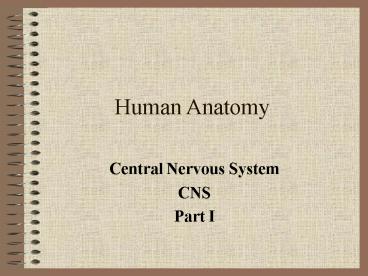Human Anatomy - PowerPoint PPT Presentation
1 / 53
Title:
Human Anatomy
Description:
Surface forms a series of elevated ridges gyri (gyrus, sng. ... Controls motor functions associated with rage, pleasure, pain and sexual arousal ... – PowerPoint PPT presentation
Number of Views:49
Avg rating:3.0/5.0
Title: Human Anatomy
1
Human Anatomy
- Central Nervous System
- CNS
- Part I
2
CNS
- Consists of 2 anatomical components
- Brain
- Spinal cord
3
The Brain
- 3 components
- A. Cerebrum
- B. Cerebellum
- C. Brainstem
4
The Brain
cerebrum
cerebellum
brainstem
5
Sagittal Brain
cerebrum
brainstem
cerebellum
6
Lateral Brain
cerebrum
cerebellum
brainstem
7
A. The Cerebrum
- Surface forms a series of elevated ridges gyri
(gyrus, sng.) - Surface also has shallow depressions sulci
(sulcus, sng.)
8
A. The Cerebrum
9
Central Sulcus
10
Lateral Sulcus
11
Longitudinal Fissure
- LEFT
RIGHT
12
Cerebral Hemispheres
- Cerebrum consists of two cerebral hemispheres
13
Lobes of the Cerebrum
14
Lobes of the Cerebrum
- Four lobes from the surface
15
Four Lobes of Cerebrum
- Frontal
- Parietal
- Occipital
- Temporal
16
1. Frontal Lobe
Precentral gyrus -- primary motor
cortex --control of voluntary skeletal muscle
- Anterior to the central sulcus
Anterior to central sulcus
17
1. Frontal Lobe
Broccas speech area Involved in speech Located
in left frontal lobe for right-handed
individuals And many left handed individuals
18
1. Frontal Lobe
Intellectual functions predicting
consequences of possible actions
19
2. Parietal Lobe
- Posterior to the central sulcus
Postcentral gyrus Primary sensory cortex Touch
pain, temp. taste
20
3. Occipital Lobe
- Most posterior portion of cerebrum
Visual cortex
21
4. Temporal Lobe
- Inferior to lateral sulcus
Auditory cortex
22
B. The Cerebellum
23
B. The Cerebellum
- 2 cerebellar hemispheres
- Functions
- Coordinates rapid, automatic adjustments to
skeletal muscle - This maintains body balance and equilibrium
- Stores memories of learned movement patterns
24
C. Brainstem
Most primitive part of brain
25
1. Corpus callosum
- Myelinated pathway that connects 2 cerebral
hemispheres - Coordinates sensory input with motor activities
26
1. Corpus callosum
27
2. Thalamus
- LR near midline
28
2. Thalamus
29
Function of Thalamus
- Serve as a relay and switching station for both
motor and sensory information - Determines routing and priority
30
CEREBRUM
Thalamus
SPINAL CORD
31
3. Hypothalamus
Just inferior to thalamus
32
Functions of Hypothalamus
- Controls motor functions associated with rage,
pleasure, pain and sexual arousal - Regulates hormone secretion of the pituitary
gland - Feeding and thirst centers
33
4. Medulla oblongata
Most primitive Part of the brain ---also
most inferior
34
Functions of medulla oblongata
- Regulation of
- Heart rate
- Respiration rate
- Distribution of blood flow and blood pressure
- Connects brain to spinal cord
- Ends at foramen magnum
35
Transition
Spinal cord begins at the foramen magnum
36
The Meninges
- Consists of 3 layers of connective tissue that
surround the brain and spinal cord - Functions as a shock absorber to prevent contact
w/ surrounding bone (skull and vertebrae) - From superficial to deep
- Dura mater
- Arachnoid mater
- Pia mater
37
The Meninges
38
The Meninges
39
Dura mater
- Most superficial
- thickest
- 2 layers
- Endosteal in contact with bone
- Meningeal deeper of the 2 layers, in contact
with arachnoid mater
40
Dura Mater
Endosteal layer
Meningeal layer
41
Arachnoid mater
Middle layer
42
Pia mater
In direct contact with brain and spinal cord
43
Pia mater
Pia mater
44
Cerebral Spinal Fluid (CSF)
Surrounds CNS ---shock absorber
45
CSF
CSF
In between 2 layers of dura mater
Similar to composition of serum
46
Epidural and SubduralHemorrhages
- Epidural
- Bleeding between skull and endosteal layer of
meninges - Source of blood is usually torn artery
- Artery pressure is high, vein pressure is not as
high - Blood builds up in epidural space
- Causes compression of brain
- Presses brainstem against occipital bone
47
1. Epidural Hemorrhage
Brainstem controls respiration and heart
rate. Compression will cause loss of those
functions.
48
2. Subdural Hemorrhage
- Deep to the meningeal layer of dura mater
49
2. Subdural Hemorrhage
- Source of blood is usually from torn vein
- Vein pressure is not high
- Not as acute (not rapid)
50
Ventricles of the Brain
- Fluid-filled cavities within the brain
- Filled with CSF
- Store CSF not make it
- 4 ventricles
51
Ventricles
52
Ventricles
L L
3
4
53
Ventricles
Connects 3rd 4th

